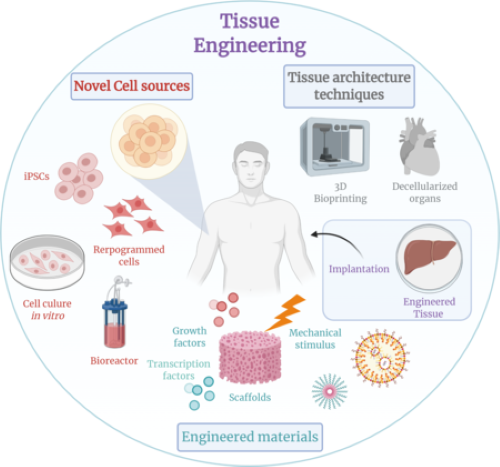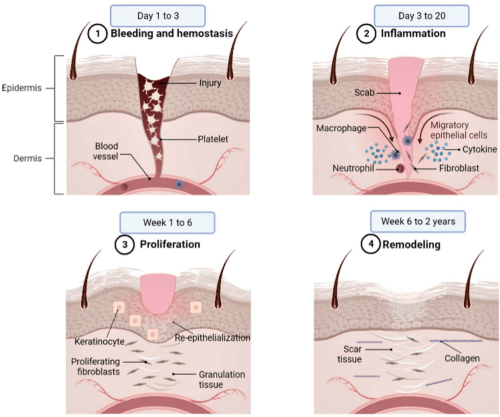
Introduction
In the evolving field of regenerative medicine, the quest for effective biomaterials that can support tissue repair and regeneration has led to the widespread adoption of Hyaluronic Acid (HA). This naturally occurring biopolymer is integral to various physiological processes, including hydration, lubrication of joints, and the repair of tissue. Its unique properties make medical-grade Hyaluronic Acid a cornerstone in the development of advanced therapies in tissue engineering, wound healing, and cell therapies.
This article delves into the multifaceted roles and applications of HA in regenerative medicine. Hope that you can learn about its potential to revolutionize treatments and improve patient outcomes.
1. Tissue Engineering: A Scaffold for Growth

Figure 1. Tissue Engineering [1]
–Introduction to Tissue Engineering
Tissue engineering aims to restore, maintain, or improve damaged tissues or whole organs. At the heart of this discipline is the need for scaffolds that can support cell growth, differentiation, and integration with host tissue.
–The Role of HA-Based Scaffolds
HA-based scaffolds have emerged as a material of choice due to their biocompatibility, biodegradability, and ability to mimic the extracellular matrix (ECM). These scaffolds provide a 3D microenvironment that facilitates cell attachment and proliferation.
–Customization of HA Scaffolds for Tissue Repair
By manipulating the physical and chemical properties of HA, researchers can create scaffolds that closely replicate the natural ECM of different tissues. This customization enables the targeted repair of specific tissues, such as cartilage, skin, and even neural tissues.
–HA Scaffolds in Cartilage Repair
For instance, in cartilage repair, HA scaffolds can support the growth of chondrocytes, the cells responsible for producing the cartilage matrix. This application is particularly significant in treating degenerative joint diseases like osteoarthritis, where HA can help regenerate damaged cartilage and restore joint function.
2. Wound Healing: Accelerating Repair Processes
Wound healing is a complex process that involves multiple stages, including inflammation, proliferation, and remodeling. Medical-grade HA has been shown to accelerate wound healing by modulating these phases.

Figure 2. 4 Phrases of Wounding Healing [2]
- Its hygroscopic nature helps maintain a moist wound environment, which is crucial for cell migration and proliferation.
- Moreover, HA can modulate inflammatory responses and reduce excessive inflammation that can impair healing.
HA’s role in angiogenesis, the formation of new blood vessels, is also critical in wound healing.
- By promoting angiogenesis, HA ensures an adequate blood supply to the wound site. In this way, it delivers essential nutrients and oxygen required for tissue repair.
- Additionally, HA-based hydrogels and films can serve as drug delivery systems. It releases antimicrobial agents and growth factors that further promote healing and tissue regeneration consequently.
3. Cell Therapies: Enhancing Efficacy and Survival
–Introduction to Cell Therapies
Cell therapies involve the transplantation of cells to treat or prevent a disease. The success of these therapies depends on the survival, integration, and functionality of the transplanted cells.
–HA in Cardiac Regeneration
HA can enhance the efficacy of cell therapies by providing a supportive matrix that promotes cell survival and integration into the host tissue. For example, in the treatment of myocardial infarction, injecting HA hydrogels loaded with cardiac stem cells into the damaged heart tissue has shown promise in improving heart function by supporting the regeneration of cardiac tissue.
–Enhancing Cell Therapies with HA
Moreover, HA’s ability to modulate the immune response can protect transplanted cells from immune rejection, extending their survival and improving the overall success of cell therapies. This property is particularly beneficial in allogeneic transplants, where the risk of immune rejection is high.
Challenges and Future Directions
Despite its potential, the application of HA in regenerative medicine is not without challenges.
- The physical and chemical properties of HA must be carefully tailored to match the specific requirements of each application. That requires advanced fabrication and modification techniques.
- Additionally, the long-term effects and degradation behavior of HA materials in the body need further investigation to ensure their safety and efficacy.
As research in this field progresses, the development of next-generation HA-based materials with enhanced properties is anticipated. Innovations in bioengineering and nanotechnology are expected to further expand the applications of HA in regenerative medicine. They offer new hope for the treatment of chronic diseases and injuries.
Conclusion
Medical-grade Hyaluronic Acid stands at the forefront of regenerative medicine. It offers promising solutions for tissue engineering, wound healing, and cell therapies. Its unique properties of biocompatibility, biodegradability, and versatility make it an invaluable tool in the development of regenerative therapies.
As research continues to unravel the full potential of HA, its role in advancing medical treatments and improving patient outcomes is set to grow. Medical-grade HA sets a new era in healthcare and therapeutic strategies.
Stanford Chemicals Company (SCC) is a premier wholesaler of organic hyaluronic acid. SCC offers a selection of pure hyaluronic acid powders in high, middle, and low molecular weights. Our natural sodium hyaluronate powder meets kosher standards and serves a variety of industries including food supplements, cosmetics, eye drops, and pharmaceuticals. Send us an inquiry if you are interested.
Reference:
[1] Tissue engineering. (2024, January 19). In Wikipedia. https://en.wikipedia.org/wiki/Tissue_engineering#
[2] Zulkefli, N.; Che Zahari, C.N.M.; Sayuti, N.H.; Kamarudin, A.A.; Saad, N.; Hamezah, H.S.; Bunawan, H.; Baharum, S.N.; Mediani, A.; Ahmed, Q.U.; et al. Flavonoids as Potential Wound-Healing Molecules: Emphasis on Pathways Perspective. Int. J. Mol. Sci. 2023, 24, 4607. https://doi.org/10.3390/ijms24054607
